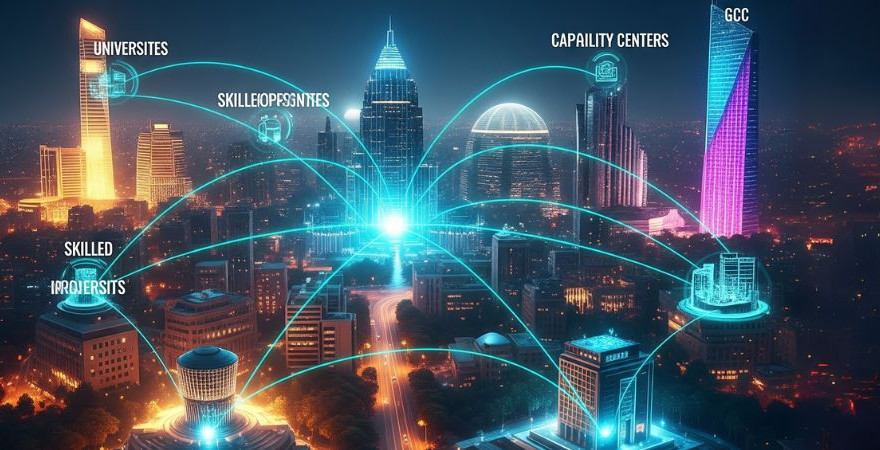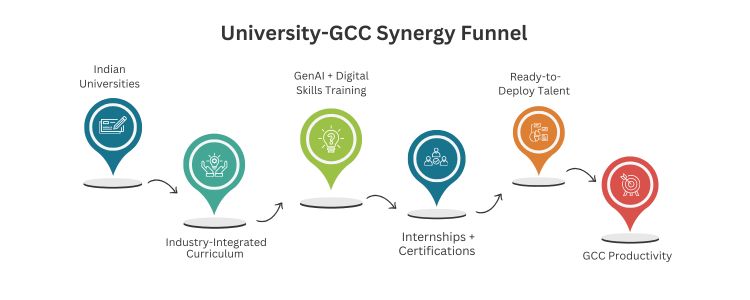
India did not rise overnight as the global center of GCC (Global Capability Center). The center of this change contains a hero who is often underestimated—the Indian university system. With the enrolment of more than 42 million students in higher education by 2024, India has created the world’s second-largest talent pipeline, which is not only fulfilling domestic demand but also fulfilling global digital changes. In FY 2023-24 alone, India paired more than 1,900 new technical startups (Tracxn)—60% of them were run by alumni or incubators of the university. From AI engineers in Bangalore to financial analysts in Pune, this growth has given a new look to the GCC ecosystem and created an annual value of $46 billion through captive centers to gain significant economic benefits through localised, high-quality, and measurable talent.
Today’s Indian University has developed beyond textbook-based education. They are innovation incubators, startup launchpads, and direct feeders for GCC. Institutions like IIT Madras, Bits Pilani and IISc are playing a leading role in global partnerships with companies like Nvidia, Qualcomm, Bosch, and Goldman Sachs. Regional universities such as SRM, VIT, and Amity are making industry-based programmes and providing skills to more than 2 million students annually in emerging techniques such as GenAI, Blockchain and Cloud. These partnerships and industry-ecology models are promoting the talent ecosystem of Indian universities, ensuring the GCC in India to ensure access to the future, digitally skilled talent.
The next region of global talent is emerging from small cities in India. Universities in Nagpur, Coimbatore, Dehradun, Indore, and Bhubaneswar are preparing highly employable digital graduates. According to the India Skills Report 2024, the digital skill adaptability in graduates of Tier-2/Tier-3 cities is 36% higher than in the Tier-1 metros. This distributed model not only reduces the cost of recruitment to GCC by 25-30% but also gives access to regional economic growth, which gives India a cost of 40-50% on Western economies while maintaining global quality standards.
GCCs depend on continuous innovation, agility, and cost-skilled scaling. Indian universities provide this. Here a table is attached to explain how: This synergy of GCC-universities ensures low attrition, high skill relevance, and direct impact on distribution capabilities.
The change of higher education in India under NEP 2020 has given a new look to courses of various subjects. University now provides these: More than 300 universities are now providing GenAI-focused modules, and GCC is exploiting talents that are not only trained but also ready for deployment. Platforms such as SWAYAM and NPtel supported by universities, have issued more than 15 million certificates in 2023, further reducing the skill gap in digital changes.
Appointments from Indian universities provide important economic and operational benefits for global firms: By integrating with universities, GCCs avoid the cost of external skills and reduce the onboarding cycle by 45 days. This strategic alignment is directly responsible for hosting more than 1800 active GCCs in India, which contributes 9% to India’s GDP through service exports, the estimated price of $100 billion by 2030.
In the next decade, GCC will co-create courses, research programmes, and even faculty development with Indian universities. We expect a surge in: By 2030, the influence of Indian universities on talent will be not only educational but also strategic and global. India’s digital transformation is growing at a 27% compound annual growth rate (CAGR), and 32 lakh technical graduates are entering the market every year, so GCCs are not only permanent in India, but they are also here to lead.
For global enterprises, Indian universities are no longer just recruitment centers – they are strategic assets. In Inductus GCC a GCC enabler in India, we directly see how university cooperation promotes innovation, flexibility, and speed. This campus-to-GCC model is the mystery of the world’s digital talent to become the capital for India. Now the time has come for the global organisation to invest not only in India but also with India. We help the companies to set up their GCC centers in India with end-to-end solutions.
Indian universities provide industry-trained, digitally skilled talent that directly supports the operation and innovation requirements of the global capacity centers (GCC). They provide highly adaptable, cost-skilled, and loyal talent pools, helping the GCC expand and also reducing the appointment cost to 30%. Through the NEP 2020 reforms, many universities now offer AI, GenAI , Cloud and cybersecurity programmes designed in association with leading institutions of industry. University-GCC partnerships ensure a seamless talent pipeline, customised training, fast onboarding, and low attrition for GCC. Universities promote incubator innovation, entrepreneurship, and intellectual property construction—nourishing GCC with both talent and technical ideas. Aditi, with a strong background in forensic science and biotechnology, brings an innovative scientific perspective to her work. Her expertise spans research, analytics, and strategic advisory in consulting and GCC environments. She has published numerous research papers and articles. A versatile writer in both technical and creative domains, Aditi excels at translating complex subjects into compelling insights. Which she aligns seamlessly with consulting, advisory domain, and GCC operations. Her ability to bridge science, business, and storytelling positions her as a strategic thinker who can drive data-informed decision-making.
How to Shape Indian University Talent Ecosystems!!
Tier-2 and Tier-3 Universities: Next Wave of Talent
GCC Synergy Model
University
Industry Collaboration
Focus Area
Impact on GCCs
IIT Madras
Qualcomm, Google
AI, Semiconductors
R&D labs + direct GCC talent placement
BITS Pilani
Siemens, Tata Elxsi
Embedded Systems
Joint curriculum + job-ready engineers
VIT Vellore
Zoho, Accenture
Full Stack, Data Science
Localised hiring + internship pipelines
SRM University
Infosys, Capgemini
Cybersecurity, Cloud
Campus-to-GCC hiring programme
Shiv Nadar University
HCLTech, Adobe
GenAI, Product Design
Future-tech talent aligned to GCC demands
From Curriculum to Career
Economic Impact: Local Talent, Global Distribution
Future approach: University as a Strategic partner in the GCC Ecosystem

Conclusion
frequently asked questions (FAQs)

Aditi
Hey, like this? Why not share it with a buddy?
Related Posts
Recent Blog / Post
- Agile Methodologies for GCCs: A Blueprint for Success October 6, 2025
- The Legal and Compliance Checklist for a New GCC Setup October 4, 2025
- The Rise of Niche GCCs: A Focus on Specialised Capabilities October 4, 2025
- The Impact of Regulatory Changes on GCC Operations October 4, 2025
- Cybersecurity for GCCs: A Proactive Approach to Data Protection September 30, 2025
- Beyond Cost: Measuring the True ROI of Your GCC Investment September 29, 2025
- The Future of GCCs in the Retail Sector: A Strategic Playbook September 29, 2025
- David vs Goliath: Mid-Sized GCCs Quietly Outperform the Big Brands September 29, 2025
- Infineon’s Big Bet on India: Inside Its First GCC in GIFT City September 29, 2025
- From Campuses to Capability Centres: How Indian Universities Power the Global GCC Ecosystem September 29, 2025
- Retail Meets Digital: Costco’s GCC in Hyderabad Marks a Global Shift September 29, 2025
- The Silent Crisis: Why Many GCCs Plateau After 3 Years and How to Avoid It September 24, 2025
- Germany’s New Skilled Immigration Act and Its Ripple Effect on the GCC Talent Model September 24, 2025
- From Tokyo to Hyderabad: The Future of GCCs for Japanese Conglomerates September 23, 2025
- GCCs as AI Acceleration Hubs: Collaborating with US and Nordic Tech Majors September 19, 2025
















